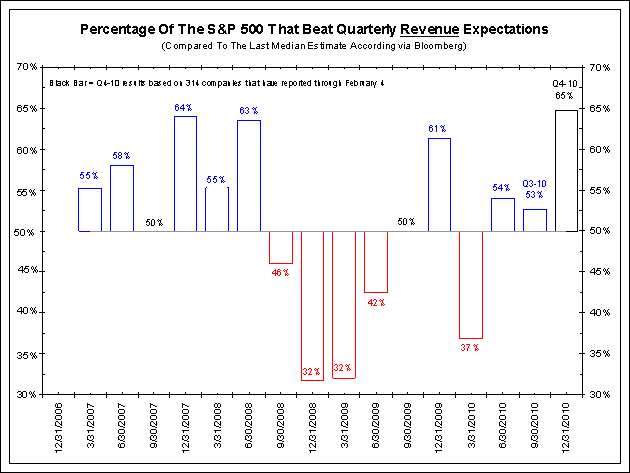- Bloomberg.com – S&P 500 Beating Estimates for Sales by Most Since 2006
More U.S. companies are exceeding sales forecasts than any time in four years, helping extend the biggest stock-market rally since 1936. Caterpillar Inc. and United Parcel Service Inc., barometers for the economy because of their building and delivery businesses, are among the 72 percent of Standard & Poor’s 500 Index companies that reported more revenue last quarter than analysts estimated, the largest proportion since at least 2006, according to data compiled by Bloomberg. Sales beat projections by an average 2.3 percent, the most in two years, the data show. While U.S. earnings have surpassed Wall Street estimates for seven straight quarters, sales have trailed forecasts on average since 2008, as the U.S. ended its worst recession in seven decades and employers cut as many as 8.75 million workers. Bank of America Corp. and Penn Capital Management say unexpected revenue growth shows the economy is expanding enough that companies can stop firing people and closing plants. “You really did need top-line growth because the cost- cutting got to where you couldn’t cut any more,” said Eric Green, a money manager at Penn Capital Management in Philadelphia, which oversees $5.6 billion. “But you’re seeing it now. Many companies are having that nice top-line growth, and as that goes up, it should have a magnified effect on earnings. It’s very positive for the equity markets.”
Comment
<Click on chart for larger image>
If you are interested, our data comes from NI ERNREVENUE <Go>. See the Q4 2010 S&P 500 Sales Summary (page 3). The Bloomberg story above used SPX <Index> EA <Go> and then selected the “Sales” button. Bloomberg often has several measures of the same thing and they often show different results. Data semantics aside, either measure is still at its highest level in years. This is good, right?
Let’s first ask ourselves, “Why are revenues beating estimates?” Is it because revenues are genuinely good or are analysts and investor relations departments gaming revenues?
The chart below shows that more than 50% of the S&P 500 have beaten earnings estimates every quarter since Q3 1998, spanning 49 consecutive quarters over 13 years. A majority of S&P 500 companies even beat estimates when earnings were in free-fall during the Great Recession in 2008.
<Click on chart for larger image>
We believe investor relations departments guide analysts below the actual earnings number, resulting in a consistent upside surprise every quarter. Put bluntly, the game is rigged. In recent years many have noted this exact phenomenon and have said investors should focus on revenues as a better metric. Now that everyone is looking at revenues, we have a record number of companies beating estimates. Yes, call us skeptical.
Lastly, as the table below shows, while 71% of companies have beaten estimates for the companies that have reported Q4 data, this is the smallest percentage since the Great Recession ended on June 30, 2009. So, a record number of companies are beating revenues while the smallest percentage since the Great Recession are beating earnings.



Ok let’s totally confuse everyone. The story above, which quotes David Bianco of UBS (no relation) says sales are beating estimates by the most since 2006. However, we have been saying the opposite. Let us explain.
From the story above, 72 percent of the companies in the Standard & Poor’s 500 reported more revenue last quarter than analysts estimated, the largest percentage since at least 2006, according to data compiled by Bloomberg.
Glancing at our Bloomberg, this is conceptually correct. As the data below shows, the actual number is 65%, not 72%, but that is the highest percentage since at least 2006 (the extent of Bloomberg’s data).